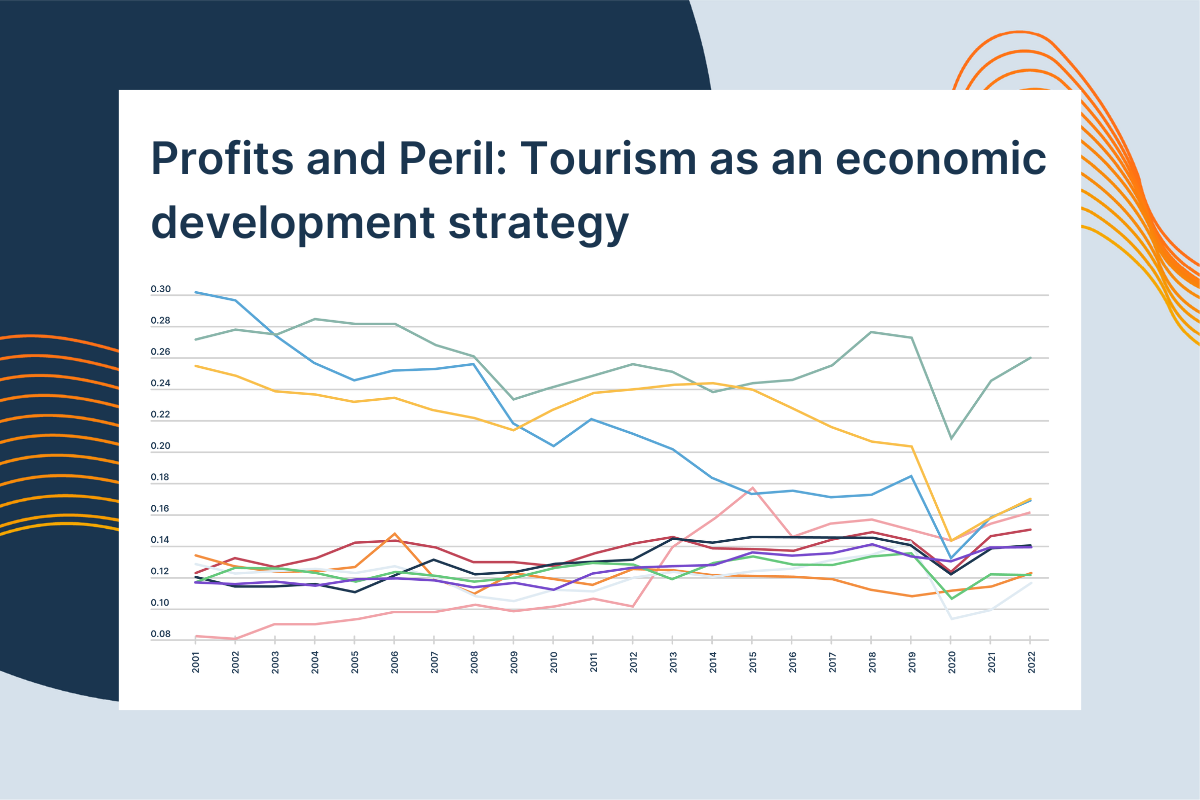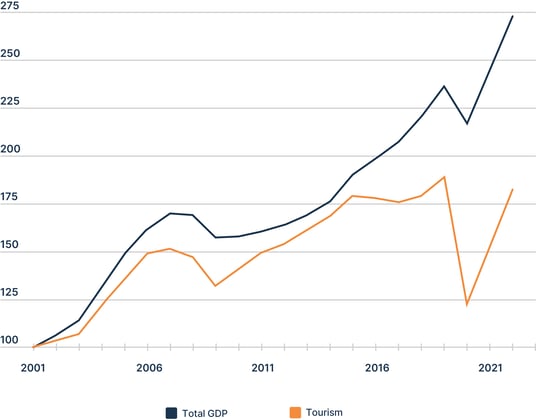Profits and Peril: Tourism as an economic development strategy

By Nolan Boyea |
Tourism is a boon to many cities, drawing in consumers who want food to eat, souvenirs to keep, and places to sleep. On the other hand, when tourism drops due to changing tastes or increasing competition, the decrease in revenue can leave governments without cash and citizens without jobs.
The highly profitable but unstable nature of tourism commonly occurs in other industries. This weakness, known as Dutch Disease, is a scenario where some industries are so profitable that everyone in the region chooses to specialize in those fields, opening these economies to extreme boom and bust cycles. This phenomenon also commonly occurs in small nations with an abundance of natural resources, and crops up in a variety of other contexts.
To better understand the impact of tourism dependence, and how and why tourism-dependent cities changed over time, Chmura examined over 20 years of metropolitan statistical area (MSA) gross domestic product (GDP) data. Specifically, we focus on a few MSAs that demonstrate large shifts (e.g., Atlantic City and Las Vegas).
Understanding the economic impact of tourism across cities
Tourism has held steady in the most tourism-dependent metro areas

The above graph displays the Tourism percentage of GPD for the most tourism-dependent[1] MSA’s in the United States. Following the 2008 recession, a relatively mild but long-lasting drop in tourism as a percentage of GDP occurred. On the other hand, only two years after it began, one notes a rapid dissipation of the dramatic impact of the COVID recession. For many cities (e.g. Kahului-Wailuku in Hawaii), the tourism percentage of GDP remains relatively constant over time, denoting the importance of tourism to many local economies, as well as the difficulty MSAs have in finding alternative industries.
In the above figure, the massive drop in tourism as a percentage of GDP in Las Vegas and Atlantic City highlights the most obvious trend. Both cities are considered gambling destinations, yet they are on opposite sides of the nation. Why are these two gaming hubs trending in the same direction? Is there a secular decline in gambling? Or are other factors at play?
Las Vegas moved to diversify economy away from tourism after significant decline
GDP shows Las Vegas economy has diversified

Home to dozens of casinos, each more extravagant than the last, Las Vegas relies on tourism to employ its populace and to fund its government. The economic gamble that Vegas took became apparent during the 2008 recession when the housing bust and resulting drawdown in consumer spending hit Vegas hard. In the above graph, tourism GDP takes three years to recover from the Great Recession, and total GDP did not recover for another four years. On the other hand, US GDP fully recovered only two years after the 2008 Financial Crisis. The slow recovery of Vegas is a clear sign of Dutch Disease, something government officials evidently noted. After this crisis, state and local leaders devised a plan to diversify their economy. They began funding medical schools, economic development organizations, industrial parks, and logistics hubs. As a result, tourism reliance has decreased, even as tourism GDP has increased significantly since 2001.
While Las Vegas put significant effort into diversifying their economy, they still have far to go. After all, tourism still comprises over 17% of GDP and is on the upswing. Improving the outlook, Las Vegas demonstrates an increasing population, a brightening economic outlook, and an active economic development plan focused on diversification.
Reliance on casinos caused trouble for Atlantic City's tourism industry
GDP tourism decline in Atlantic City caused by casino closures

Despite maintaining the same downward trend in tourism percentage of GPD and similar status as a resort town, Atlantic City tells a different story. Atlantic City experienced a precipitous drop in tourism GDP since 2001, falling to below 80% of what it was in 2001 before rebounding slightly in 2022 to just above 90% of its level in the year 2001. The reason for this downward trend may be the unintended consequence of a 1970s revitalization effort. In 1976, Atlantic City threw open its doors to casinos in a bid to bring new life to its declining resort business. With gambling widely outlawed at the time, Atlantic City quickly became a popular gambling destination, and money flowed to the casinos and the government. Once other municipalities realized the moneymaking capabilities of casinos, they also began legalization processes. Failure to compete in the increasingly crowded East Coast market culminated in the closure of four casinos in 2014, leaving Atlantic City with a massive budget shortfall that they resolved with great difficulty.
In recent years, the economic outlook improved. In 2018, two closed casinos reopened under new management and rapidly became the best-performing casinos in the area. On the other hand, much of the new casinos’ success came at the expense of current casinos, limiting their additional contribution to GDP and employment. Given the narrow concentration on tourism, Atlantic City remains vulnerable to a downturn, although they theoretically could increase their economic resilience by following the example of Las Vegas and diversifying their economy.
Tourism can play a big role in economic impact, but is often a temporary solution
Overall, two clear, diverging outcomes from tourism emerged in the Atlantic City and Las Vegas metro areas. In the case of Atlantic City, casinos, a temporary and last resort solution, closed. They lacked industries which could provide other solutions. Las Vegas, on the other hand, used tourism to build the city, but discovered that tourism provided a weak basis for an economy. To remedy this, they chose to utilize funds earned through tourism to broaden their economic foundation, moving towards a more resilient economy, and benefitting the government and the population.
1 We define tourism dependency as the percentage of GDP derived from the tourism industry, this graph displays cities in the 98th percentile of tourism dependence.
Subscribe to the Weekly Economic Update
Subscribe to the Weekly Economic Update and get news delivered straight to your inbox.











